Ah, B2B marketing. It’s a tricky beast. The products and services aren’t usually as glamorous as B2C (unless you’re an onlooking, growth-hungry VC), it takes longer to build an audience, and the work you do now may not pay off for a while. The truth is B2B marketing is a lot harder to do. And that’s why, frankly, most B2B marketing sucks. (Yeah, we said it.) But it doesn’t have to.
With the right knowledge, insight, and strategy, you can craft a B2B marketing strategy you’re proud of—one that will grab the right people’s attention, get them to convert, and deliver the type of results you can’t wait to report on. But how do you create that strategy? What do you need to actually put it into practice? And what mistakes can you avoid along the way? Great questions, and we’re here to answer them all.
For more than a decade, our agency has helped B2B brands of all sizes, across all industries, meet their customers where they’re at and turn them into lifelong fans—one piece of content at a time. Along the way, we’ve made mistakes, learned memorable lessons, and figured out what really works when it comes to B2B marketing. But even with all this hard-earned knowledge, we still remember the painful early days when we were hacking through the wilderness alone. We would have killed for a guide on that path—a helpful tip, resource, book, or guide to make sense of it all. So that’s exactly what we’ve created for you.
In this guide, we’re breaking down everything you need to know about B2B marketing, along with a step-by-step streamlined process to create a solid B2B marketing strategy and a free 10-template toolkit to help you through every stage. Whether you’re building your B2B marketing operation from scratch or trying to get your marketing back on track, this is the perfect place to start.
STOP! Before you dive into this guide, download our free B2B Marketing Strategy Toolkit to walk through the steps outlined in this post.
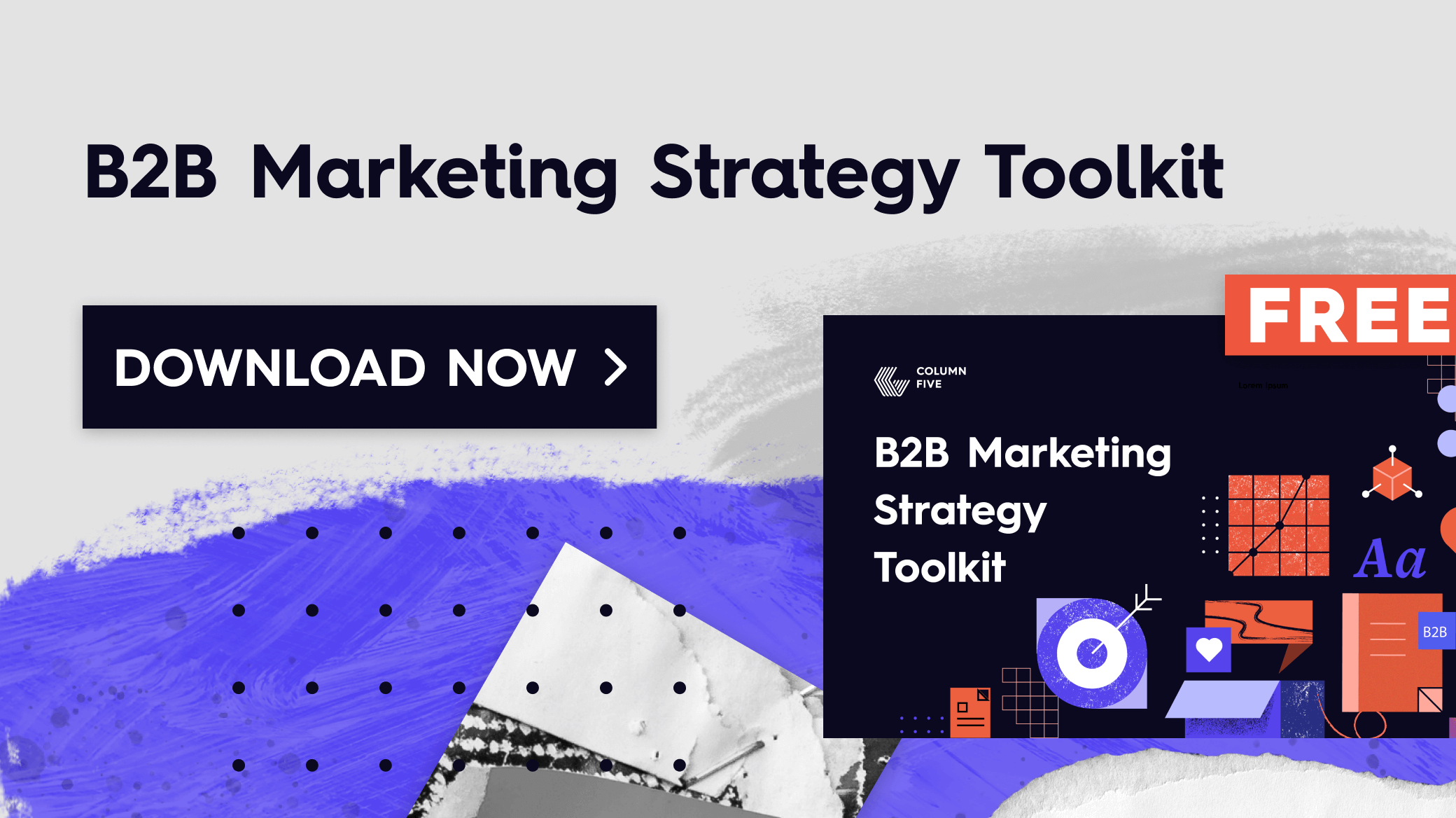 ________________________________________________________________________
________________________________________________________________________
TOC
Note: While we recommend reading through the entire guide, you can jump to the parts you need if you’re short on time.
- What Is B2B marketing?
- What Is the Difference Between B2B and B2C Marketing?
- What Does B2B Marketing Look Like?
- What Are B2B Marketing Channels?
- What Are the Keys to Good B2B Marketing?
- What Do You Need to Do B2B Marketing Successfully?
- How to Create a B2B Marketing Strategy
- How to Improve Your B2B Marketing Going Forward
________________________________________________________________________
What Is B2B marketing?
B2B marketing is short for business-to-business marketing. Unlike B2C (business-to-consumer), where you’re marketing a product or service to an individual, B2B is marketing your product or service to a business or organization (including governments, institutions, nonprofits, etc.). Think of B2B marketing as selling computers to a university versus selling a laptop to a student.
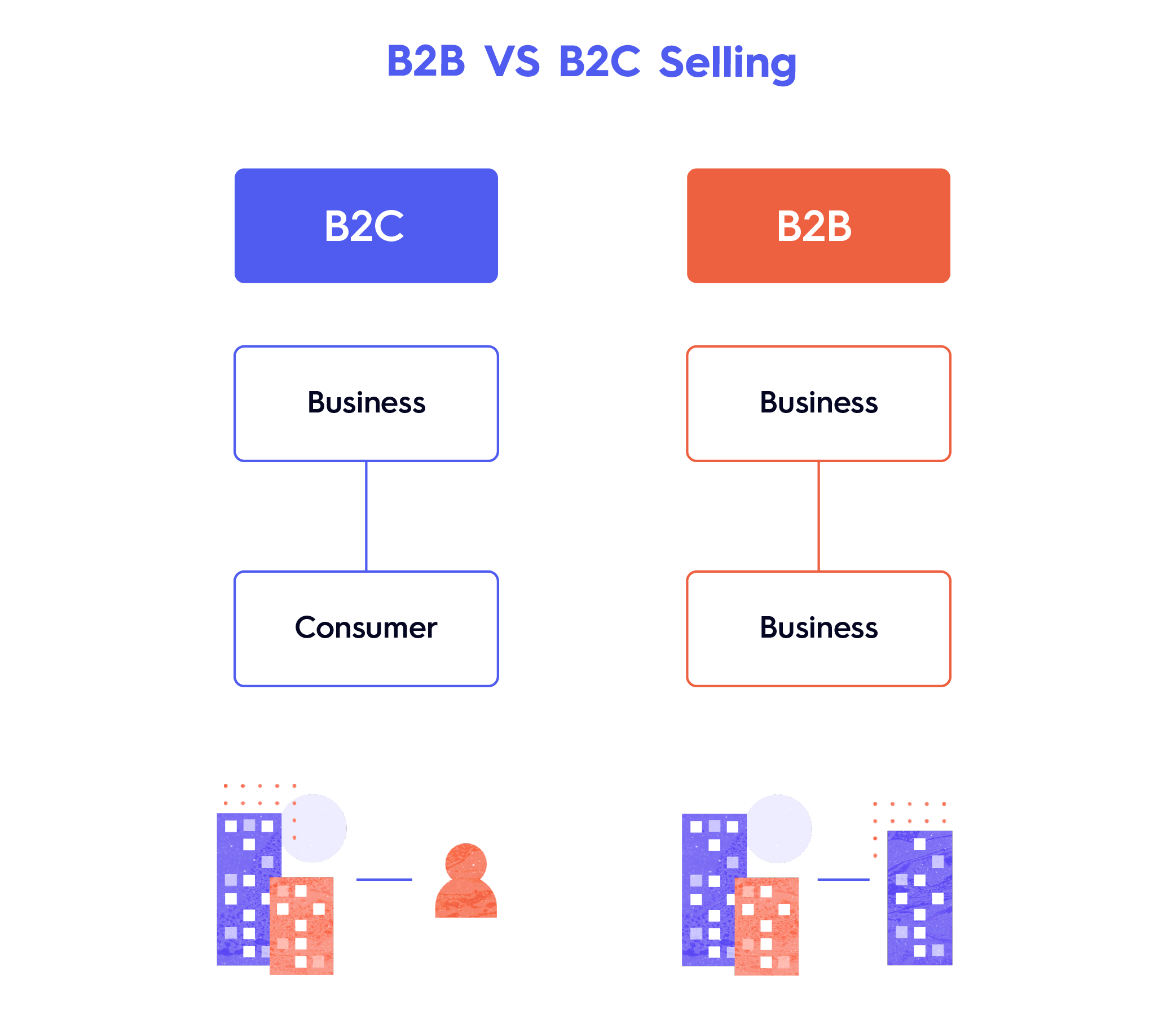
What Is the Difference Between B2B and B2C Marketing?
Aren’t B2B and B2C both selling to people? Fundamentally, yes. But the journey to becoming a customer looks very different.
In B2C marketing, you get quick (albeit short-lived) success. In B2B, you’re playing the long game.
In B2C, you’re selling a product or service to one person. The cost is usually lower. The decision is more direct, and often impulsive. The motivations are emotional (and unique to the buyer only). The purchase is typically transactional.
In B2B, you’re selling a product or service to an entire organization. (Business products and services are larger investments, which justifies the role of accounts teams to ensure satisfaction with the purchase, manage customer needs, and retain and grow accounts.)
The market is smaller (think 500 companies vs. 5 million consumers), and although there may be one buyer, there are multiple stakeholders, the cost is much higher, the sales cycle is much longer, and you work harder to get those customers. The good news? The payoff is much greater.
The average number of stakeholders that influence a B2B buying decision is 11—and sometimes up to 20.
—Gartner research
B2B commerce is much more about relationships. In fact, that relationship often begins years before there’s a sale, which is why it’s so important to position your brand effectively and create content that nurtures that relationship.
That said, it’s true that even when you’re marketing to a business buyer, you’re actually marketing to the individuals at those businesses. (Treating your B2B audience like a faceless corporation is one of the biggest mistakes—but we’ll get into that later.) So although B2B marketing takes longer, the focus is still on cultivating that core relationship with your buyer, whether that’s an individual or a whole department.
Note: As more companies are expanding to include both B2B and B2C offerings, the lines are blurring. But B2B still requires its own unique strategy.
For a deeper dive, see our breakdown of B2B vs. B2C marketing.
What Does B2B Marketing Look Like?
From articles and interactives to video and brochures, B2B marketing takes many forms. When we start to build a content strategy, we focus on the five key pillars of marketing content. Thinking about your content ecosystem this way makes it easier to spot gaps and content opportunities too.
5 Types of B2B Marketing
- Brand Content: This is content about your company (not your product), including who you are, your Brand Heart (purpose, vision, mission, values), and brand messaging (tagline, value prop, messaging pillars). Some of this content may be internal-facing only; some may be external. This is valuable content that helps people feel connected to you, aligned with your values, and part of your community without getting into the nitty-gritty of your business offerings.
- Editorial Content: This is content meant to educate, entertain, inspire, or demonstrate your brand expertise. This can include all types of content—often in the form of thought leadership or actionable advice, such as articles, guest posts, infographics, podcasts, videos, etc. (If it helps bring it home a bit, you’re reading a piece of editorial content right now.)
- Product Content: Naturally, there is a difference between sales and marketing content. An oft-forgotten piece of any successful content strategy, this pillar is for deeper-funnel content, particularly informational content related to your products or services that’ll help buyers gain trust. This includes content about what you do, such as sales materials, one-sheeters, interactive or motion demos, product trials, explainer videos, etc.
- Talent Content: Talent content is all about your employer brand, culture, etc. It’s geared toward prospective employees, as well as current employees. It’s basically everything people would want to know about what it’s like to work for your company: what your culture is like, who works for you, what life is like behind the scenes, etc. It’s also a way to celebrate and acknowledge those who do work for you and make them feel more connected to the company.
- Performance Content: This is tactical content used to drive a specific KPI, such as landing pages, CTAs, PPC, etc.—basically anything that doesn’t fit neatly into one of the buckets above. It’s often supplementary content for campaigns related to other pillars. While less comprehensive than other content types, it plays a vital role in achieving marketing KPI.
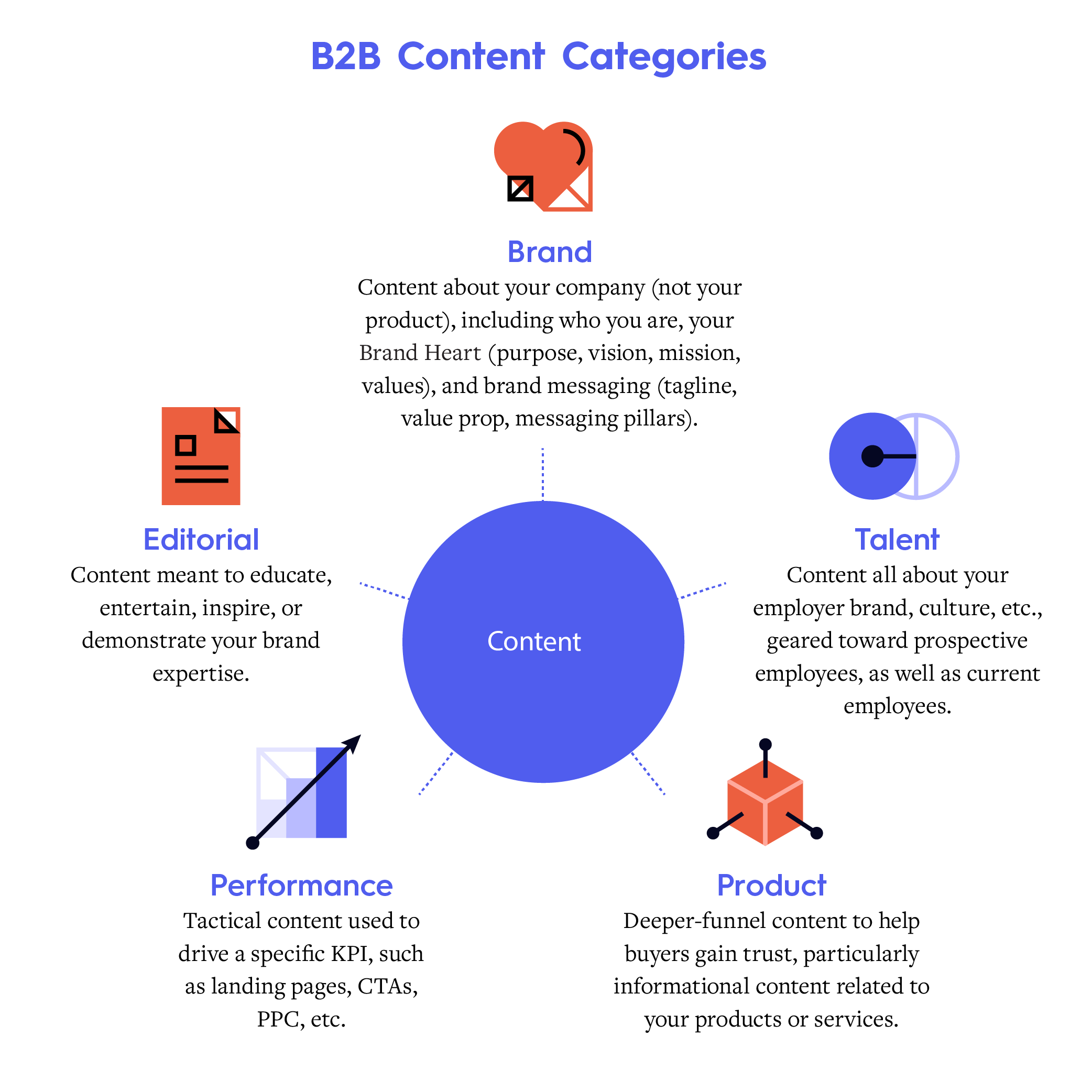
Learn more about how to incorporate the five types of content into your B2B strategy.
These five types of content can (and should) take many forms across the customer journey, depending on your audience and channel.
While your content idea may fall under one of the five B2B content pillars, the actual format it should take is another factor to consider. In general, there are three main types of formats.
3 Types of Content Formats
- Static content: This is content that, well, doesn’t move—but that doesn’t mean it can’t move readers! It can be visual, text-only, or a mix of the two. This can take all sorts of forms, such as:
- Annual reports
- Articles
- Ebooks
- Infographics
- Research/White papers
- Photos
- Social Media Content
- Interactive content: Interactive content is content where you can direct the experience via user interactions and inputs. There are usually two approaches. In narrative interactive experiences, users are guided through a specific experience (e.g., an interactive presentation or campaign microsite). In exploratory interactive experiences, users explore as they like (e.g., a large data visualization that you can manipulate as you desire). Both serve a unique storytelling function, but all interactive experiences engage viewers. Interactive formats are used for a variety of content, such as:
- Data storytelling
- Entertainment experiences
- Product demos
- Presentations/slideshows
- Tools
- Quizzes
- Demonstrations
- Dashboards
- 3D maps
- Games
- Video: Video is a powerful format to connect with audiences, helping to communicate information quickly, effectively, and in an entertaining package. Videos may be live-action, motion graphics (aka animated video), or a hybrid of both. Whether it’s a big, vision-level brand video on your website or a simple Q&A on Facebook Live, video can help you communicate your brand in many helpful ways, including:
- Commercials
- Culture marketing
- Case studies
- Data visualizations
- Product reviews
- Explainer videos
- Testimonials
- Tutorials
- Promotion
- Sales collateral
- Social media
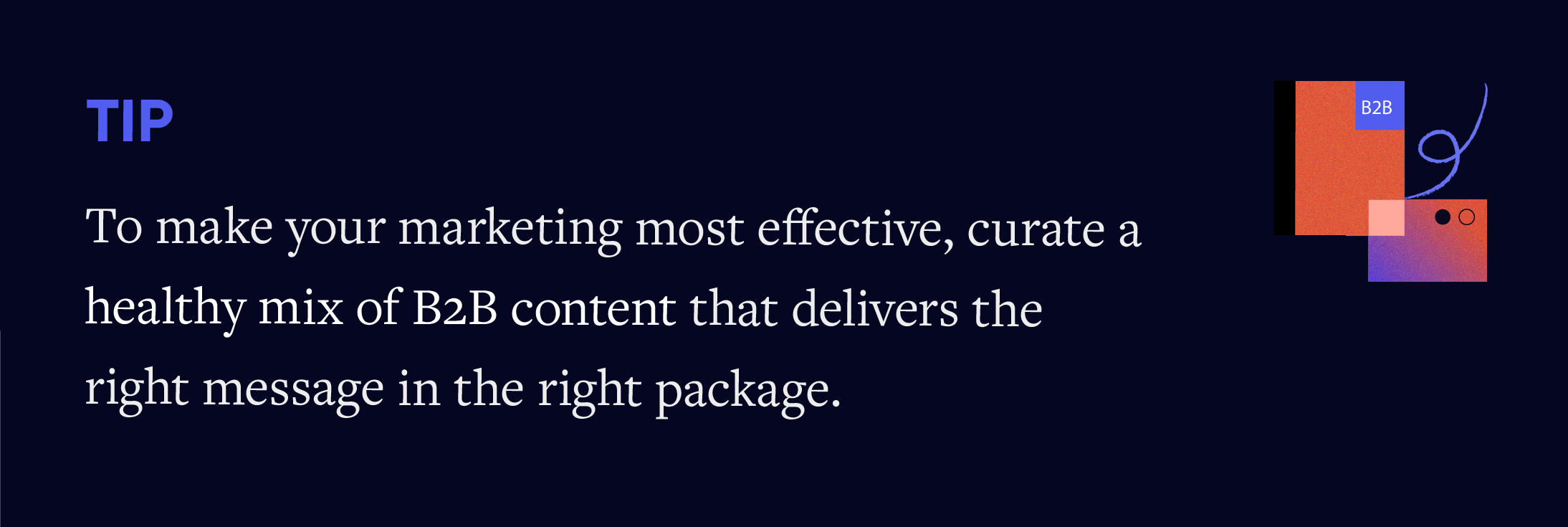
What Are B2B Marketing Channels?
B2C and B2B marketing channels are similar (overall), but because you’re targeting different audiences with different intent, you want to hone in on the channels where your audience lives.
In B2B, your most valuable channel will always be your website, including publishing areas such as your blog.
Beyond the website, we tend to break it down into two tiers of priority: SES (social, email, search) and everything else.
SES (Social, Email, Search)
1) Social: Naturally, these are the social platforms where your audience lives. Some will be much more effective than others, and figuring out the right channel-specific balance of organic vs. paid is different for each brand. (According to the Content Marketing Institute, 77% of B2B marketers say LinkedIn produces the best results.) But these may include:
-
- TikTok
- YouTube
Note: You may be surprised by which channels are most fruitful for you. We get a surprising number of MQLs from Pinterest, which is not a platform we would have prioritized initially.
2) Search: Organic search is gold when it comes to your B2B marketing strategy. Having a strong keyword strategy and optimizing your site for traffic will help you attract the right people and move them along the path to purchase. Paid search can be an effective way to drive qualified, high-intent traffic without the longer-term effort of SEO, but it requires close management and may still take some time to achieve the costs per result you’re looking for.
3) Email: Email marketing is one of the best ways to nurture your audience, get consistent facetime, and build relationships. The most conventional way to stand up B2B campaigns is by creating a gated asset that requires an email to download, and then entering that email into a long-term nurture stream that nudges them closer to becoming a customer.
Everything Else
These additional channels may have particular value for some brands:
- Public relations
- Publication placements
- Programmatic
- Content syndication
- Stunts/guerrilla marketing
- Events
- Broadcast
- Out of Home (OOH)
- Connected TV
- Sponsorships
Note: Many of these require deeper expertise to effectively utilize.
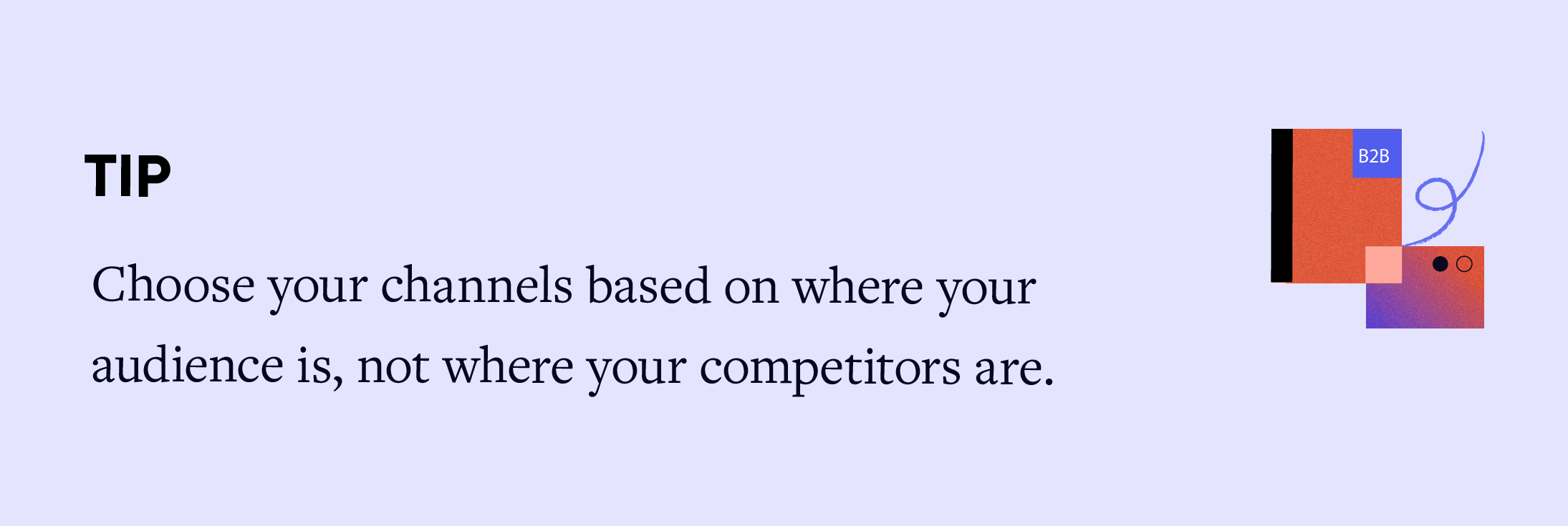
What Are the Keys to Good B2B Marketing?
Sure, B2B marketing isn’t always as sexy as B2C (and you can’t expect that shot of serotonin that comes from an instant sale). But just because you’re marketing to businesses doesn’t mean your content has to be boring. Unfortunately, so many B2B marketers are churning out content that is dry, dull, and dated. (Seriously, why do so many ebooks look like they were made from PowerPoint templates from the ‘90s?!)
Business marketing doesn’t have to be boring marketing.
The good news is you have a huge opportunity to outshine your competitors in every way—if you understand the fundamentals of good B2B marketing. Your job is to create content that piques your audience’s interest, keeps them engaged, and builds a relationship. There are many ways to do that.
- Make it relevant. The first hurdle is grabbing your audience’s attention. Talking about the things you want to talk about (but have little to do with your audience) won’t get you anywhere. You need to create content that speaks to your audience’s unique needs and wants. That is the stuff that will make them stop scrolling.
- Provide value. You can talk and talk and talk until the cows come home, but if the content you create doesn’t actually give your audience something worthwhile, they will move on quickly. You want people to feel like any time they spend with your brand is time well spent—even if they’re reading a quick article. Whether you’re sharing a handy tip on social media, publishing an inspiring testimonial on your site, or sharing a unique perspective in an industry publication, you need to deliver value to your audience in some way.
- Differentiate yourself. In B2B, you have a lot of competition and a smaller market. Building relationships is the key to long-term success, but first people need to get to know you, which means they need to see you. There are many ways to differentiate your content (and, again, the bar is low), so make the most of every opportunity. From the topics you cover, to your visual identity, to your brand voice, do everything you can to make your brand instantly recognizable.
- Produce quality. This is one of the biggest problems in B2B. Your content is a big part of your brand experience, as it’s usually the first interaction people have with your brand. If you’re presenting mediocre design or articles full of fluff, that low-quality content will only erode your brand in your audience’s eyes. Again, respect their time and take pride in creating high-quality content that provides that value.
The more you stick to these fundamentals, the easier it will be to turn your audience into lifelong fans.
Only 32% of B2B marketers say they differentiate their content from the competition.
—Content Marketing Institute’s 2022 B2B Content Marketing report
Luckily, even if you don’t have a Fortune 500 marketing budget, you can still create the type of content your specific audience needs and wants. Just make sure it meets this criterion.
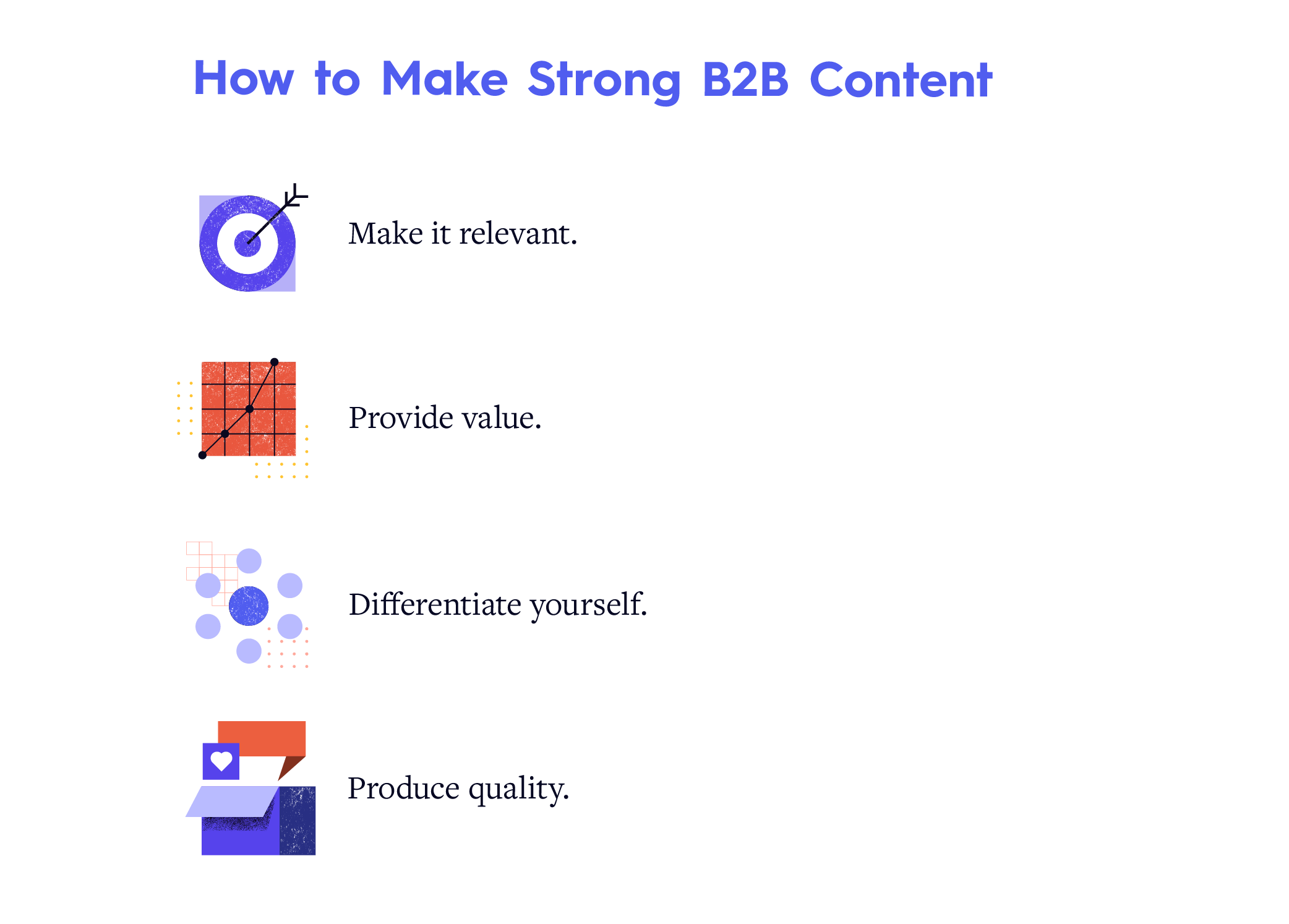
What Do You Need to Do B2B Marketing Successfully?
Now as harsh as we can be in our critiques of B2B marketing, we know that content marketing isn’t easy to do. There are plenty of moving parts, it requires knowledge and skill, and many marketers are just trying to make do with what they have.
But if you want to have a mature marketing organization, you need three core elements aligned: Your organizational structure, technology, and strategy.
Over 56% of B2B marketers are not confident that their marketing strategy, technology, and team structure are capable of effectively supporting their marketing goals.
—State of Marketing Maturity (Integrate)
1) Organizational Structure
If you don’t have buy-in from your team, your communication is siloed, or your team doesn’t have the skills to actually execute your plans, it will be incredibly difficult to produce marketing that gets results. Hence, it’s important to have:
- The right team: We think of content marketing teams not as a group of specific titles but as a group of people who cover the required roles needed, from project managing, to copywriting, to designing. (This is especially true for B2B marketers working with tiny teams.) For more on this, find out how to build a kickass marketing team. You can also find out how to optimize your content creation process to work more effectively.
- Knowledge: While a big part of a marketer’s job is staying up-to-date on the state of marketing, you also need the skill and knowledge to execute content effectively. Whether you want to build a data-heavy interactive, edit a video, or design an infographic, you need the right knowledge, which may be very niche.
- Bandwidth: Even if your team does have the knowledge, you may not have the bandwidth to do everything you need to do. In those cases, you may need to outsource your marketing to a freelancer or agency.
Misalignment or gaps in any of these areas is bound to cause trouble (as we’ve seen time and time again in our clients).
2) Tech
B2B buyer behavior is changing, as more and more of the sales process moves online.
In fact, according to Gartner research, only 17% of a B2B buyer’s time is spent with reps—the rest is online research and internal meetings. Additionally, 44% of millennials prefer no sales rep interaction in a B2B purchase setting.
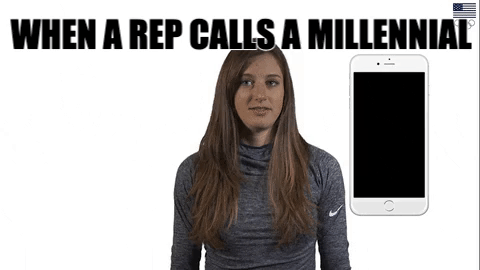
As Millennials move into more decision-making roles, creating a strong digital experience will be absolutely vital to move your audience along the customer journey. Good tech is crucial to support digital buying experiences and automation, whether you’re a 3-person team or a 300-person team.
As you assess your tech stack, consider:
- Are tools fully integrated? You should use tech and tools that allow you to deliver a seamless omnichannel experience. Luckily, there are more tools to help you be a successful marketer than ever.
- Is your tech functional? Everything should be in active use and properly functioning. (There is nothing more frustrating than missing out on precious data because a pixel isn’t appropriately placed.)
- Is your tech insightful? Does your tech provide accurate and meaningful data to help you make better decisions?
The better your infrastructure is set up, the easier it is to test and experiment, identify what works most effectively, and deliver ROI.
3) Strategy
B2B marketing is already challenging. Without a strategy, it’s damn near impossible to do it effectively. But not all strategies are created equal.
Only 40% of B2B marketers have a documented content strategy.
—Content Marketing Institute’s 2022 B2B Content Marketing Report
To make sure your content strategy has legs, it should be…
- Documented: A shocking number of marketers don’t have a documented strategy. (Let’s hope your competitors are in that group.) Not only do you need a strategy to keep everyone on the same page (literally) but it’s the key to being able to measure and track your progress. When it comes time for budget, promotions, and raises, a documented strategy will serve as evidence of your success.
- Aligned to your company’s goals: This one sounds obvious, but departments often get siloed, focusing only on their own immediate needs and goals. We can’t tell you how many times we’ve seen a marketing strategy that looks great on paper but is actually hugely misaligned to a company’s larger goals—like when a marketing team builds a strategy to promo a product or service that a different department is trying to phase out. If you want your work to move the needle, the right B2B strategy is the place to start.
- Measurable: Again, in marketing, being able to measure your success is everything. One of the biggest mistakes we see over and over is content strategies that sound great but aren’t really measurable. While there are plenty of intangible things that marketing can achieve (e.g., improving reputation), you need concrete parameters to determine whether what you’re doing is working or not.
Granted, every marketing organization is a work in progress, and there is always room to improve and mature. But you need a strong foundation to do any of this work successfully.
How to Create a B2B Marketing Strategy
While we can’t realign the way your team communicates or implement your tech today, we can help you build a B2B marketing strategy that gets results. Follow the steps we’ve outlined here (in this specific order) to build a functional strategy that helps you connect with the right people.
Step 1: Do a content audit.
You might think your B2B marketing starts with a brainstorm, but that’s the last place to start. In fact, the momentum of a fresh brainstorm can take you far off course if you don’t have your fundamentals established. That’s why, before you build a fresh strategy, you need to understand the current state of your marketing. We recommend starting with an audit of your own content, as well as your competitors’ content. This process will shed light on how you stack up to the competition, what opportunities you’re missing, and what you might adopt to improve your marketing at every touchpoint.
How to Do It
Use the Content Audit Template, and see our guide to conduct a content audit.
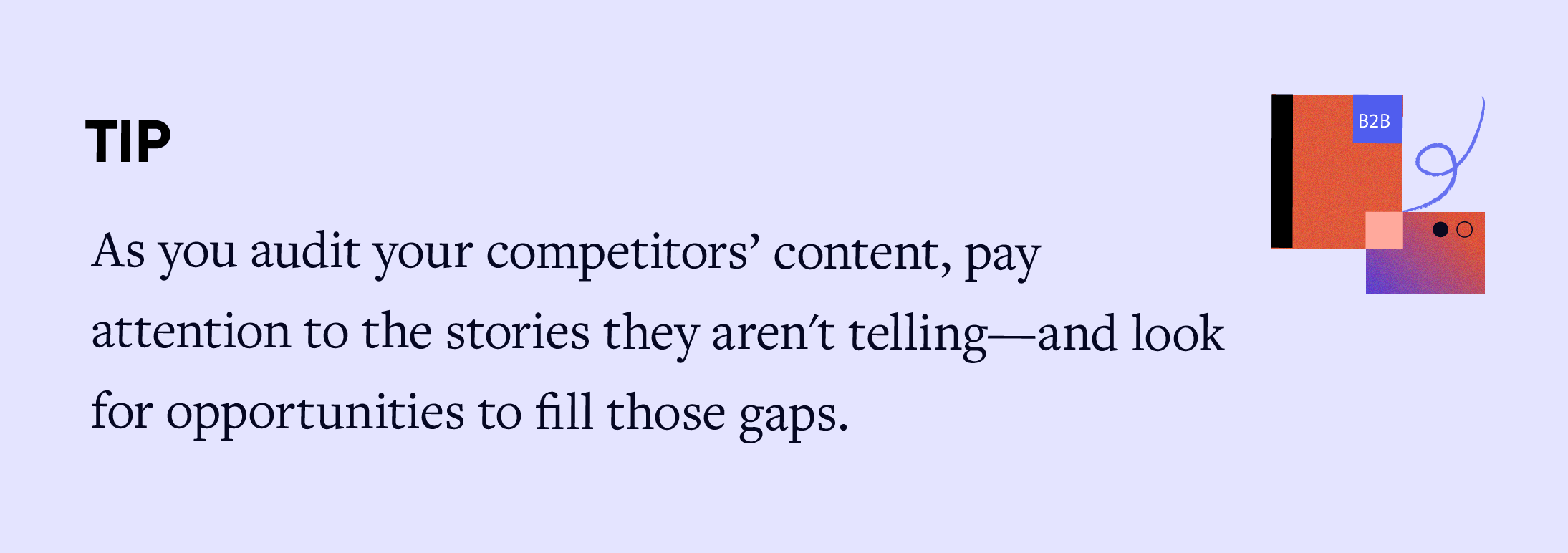
Step 2: Assess your tech stack.
Tech plays a huge role in your ability to execute your strategy at any level. But it’s not just about having the most tools and tech; you need the right tools and tech. Assess your current roster to understand whether or not you’re working as effectively and efficiently as possible. This includes tech used across marketing, including:
- Website and web analytics
- Content scheduling and publishing platforms
- Blog
- Social media platforms and tools
- Content Management System
- Proprietary data collection and storage
- Social listening tools
- Audience profiling tools
- SEO tools
- Design and charting tools
- Marketing automation
- Email marketing
- Customer relationship management software
- Paid media platforms and software
- Landing page builder
By auditing these tools, you may find functionalities that overlap, subscriptions that can be downgraded (or canceled entirely), or multiple tools that can be consolidated into one. Additionally, clarity into what you use, what’s working, and what you may need to add can help you get much-needed buy-in and budget.
How to Do It
Use the Tool and Tech Stack Template to document the current tools, technology, and resources you currently use. As you document, ask yourself:
- Do your tools cover your needs?
- Do you have duplicative tools that can be consolidated?
- Does everything function properly? (Look out for zombie subscription charges from past employees, vendors, etc.)
- Do you have good UX?
- Is automation working correctly?
- Do all the people who need access to platforms have it, and not more than necessary?
- Does every platform have someone in the organization who’s proficient in using it?
- Do your tools report on the most important metrics?
Step 3: Set your goals.
While we all want our marketing to be “successful,” success may be defined differently for every marketing organization. This is why we are such sticklers for creating measurable goals that are aligned to your company’s larger goals.
To do this, we prefer the OKR method (Objectives & Key Results). This helps you clarify specific goals and break them down into measurable results. This way you can track your progress and confidently report on the outcome. Most importantly, it allows you to intelligently adjust your strategy to improve said results.
60% of B2B marketers fail to align their department goals with company goals.
—State of Marketing Maturity (Integrate)
How to Do It
In this step, you’ll document three things:
- A Content Strategy Statement to explain the big picture of what you’re trying to do.
- Objectives that clearly define your content strategy goals.
- Key Results that help you measure your objectives.
Use the OKR Goals Template, and follow the steps in our guide to set marketing goals you can measure.
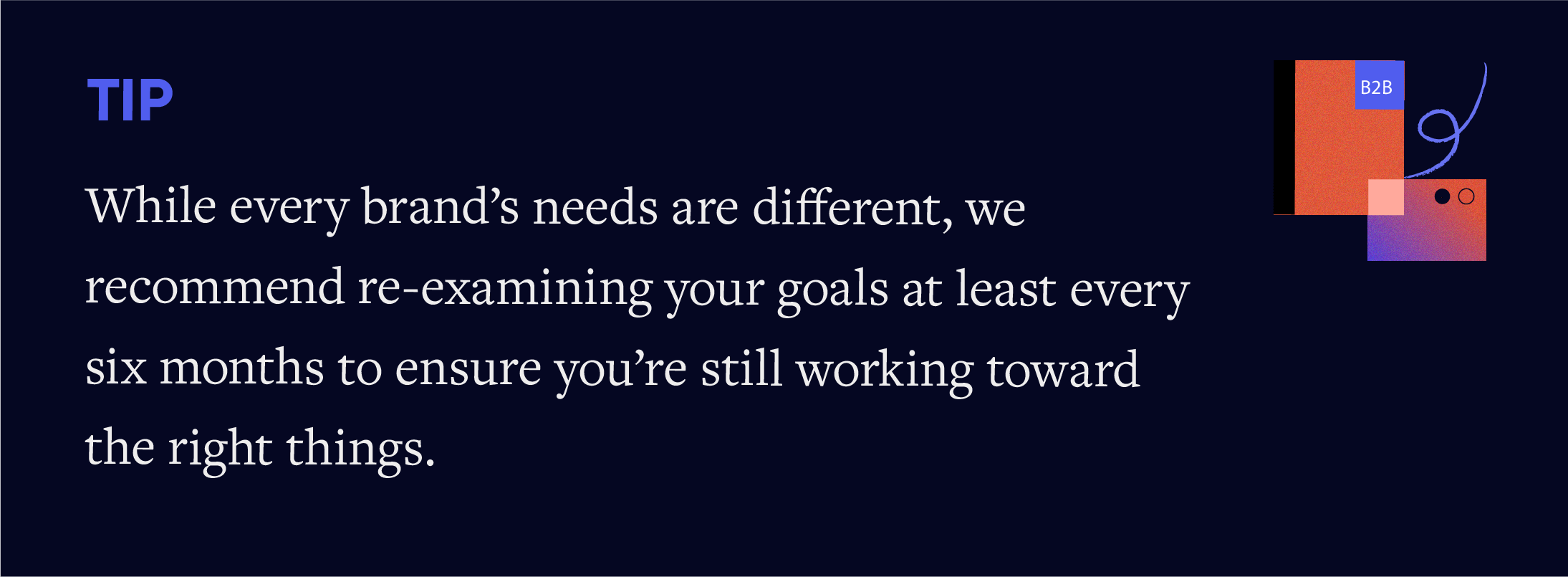
Step 4: Know your audience.
Although you’re selling “to” a business in B2B, your decision-makers are still individual people. If you want to catch—and keep—their attention, you need to know who they are, what problems they face, what solutions they want, what makes them tick, etc. The more you know about them, the better you can tailor your content to their unique needs. Remember that the sales cycle is much longer in B2B and the stakes are higher, so building relationships through content matters even more.
Additionally, in B2B there may multiple decision-makers and influencers, including:
- Main point of contact
- Influencers (peers, colleagues, bosses)
- Blockers (often IT).
It’s important to both understand and map these relationships to speak effectively to your customer (and their cohorts).
How to Do It
To understand your audience, Use the Personas Template to clearly document who they are and what they care about. Not sure who your audience is? Here are 5 hacks to figure it out.
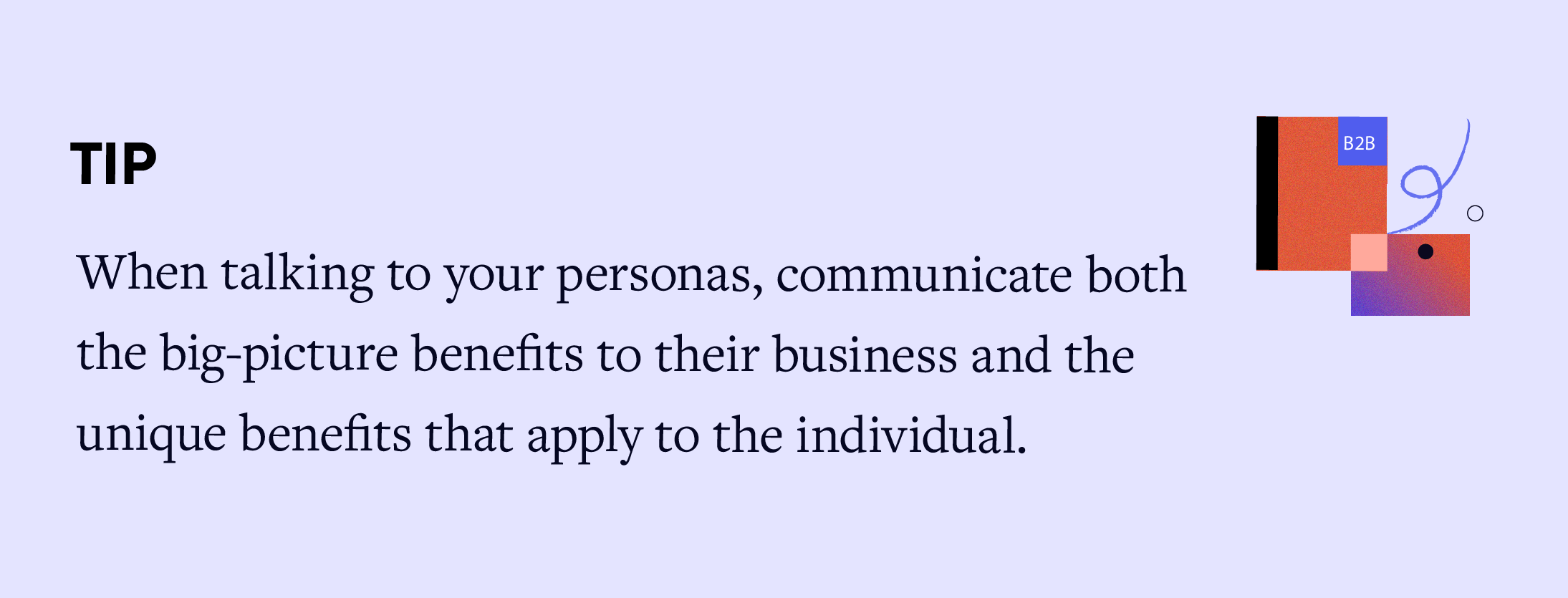
Step 5: Map your customer journey.
If you want your B2B marketing to be effective, you need to say the right thing at the right time. Come on too strong, too early and you’ll turn people off. But if you’re not proactive when they’re ready to buy, you might push them into your competitors’ arms. So, to make sure you’re creating a seamless experience, you need to understand your customer journey, what they need to hear at each stage, and optimize your content to deliver exactly that.
Remember that, by definition, the customer journey is not a linear process of “pushing” your buyer from one stage to the next. This might be the way it looks on paper, but each buyer’s journey is inherently their own. You can “suggest” next steps to them at every opportunity through calls-to-action and other tactics, but you’ll never wholly control their path. The idea is to accommodate each stage by answering their concerns and curiosities appropriately.
How to Do It
Use our Customer Journey Template, and follow our guide to map your customer journey to document each stage, identify messaging, and make sure your content tells a consistent, cohesive story.
Step 6: Know how you’re going to measure.
A strategy you can’t measure isn’t really a strategy at all. Unfortunately, this is where marketers face challenges. They either aren’t measuring at all (yikes) or aren’t measuring the right things. To be fair, it’s easy to get lost in data, and not all goals are easily measurable. But that’s why identifying exactly what you’re going to track from the jump helps you stay focused on the right things.
Only 36% of B2B content marketers say their team’s ability to demonstrate ROI is excellent/very good.
—State of Marketing Maturity (Integrate)
How to Do It
See our guide to choose the best metrics for your content strategy, and ensure the OKRs in your Content Strategy Goals Template use the right measurement metrics.
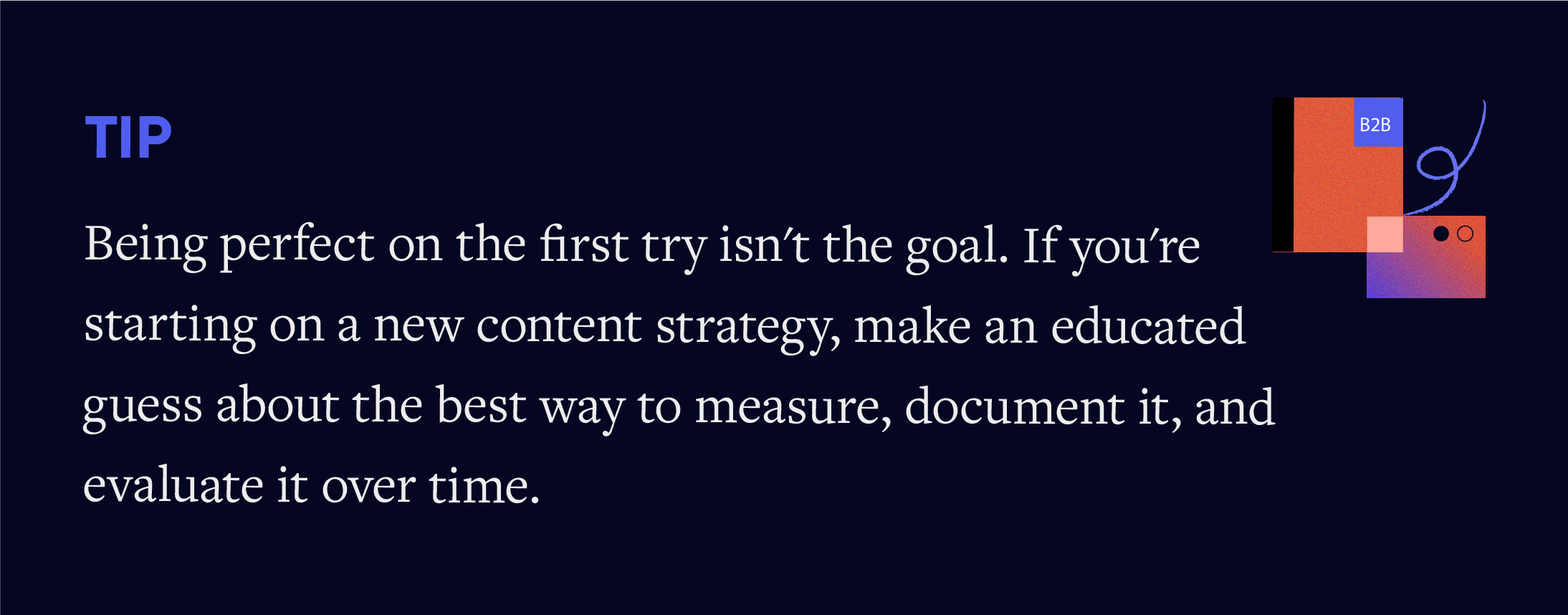
Step 7: Craft your distribution plan.
No matter how good your content is, if you can’t get it in front of the right people, it can’t do its job for you. Additionally, with so many ever-changing platforms, it’s crucial to create the right type of content for the right channel.
We like to break distribution into Primary, Secondary, and Experimental channels. This helps you understand where to put the most money and energy (and, again, helps you choose the right ideas and format for the content itself).
How to Do It
See our helpful guide to craft a solid distribution strategy, and find out how to choose the best channels.
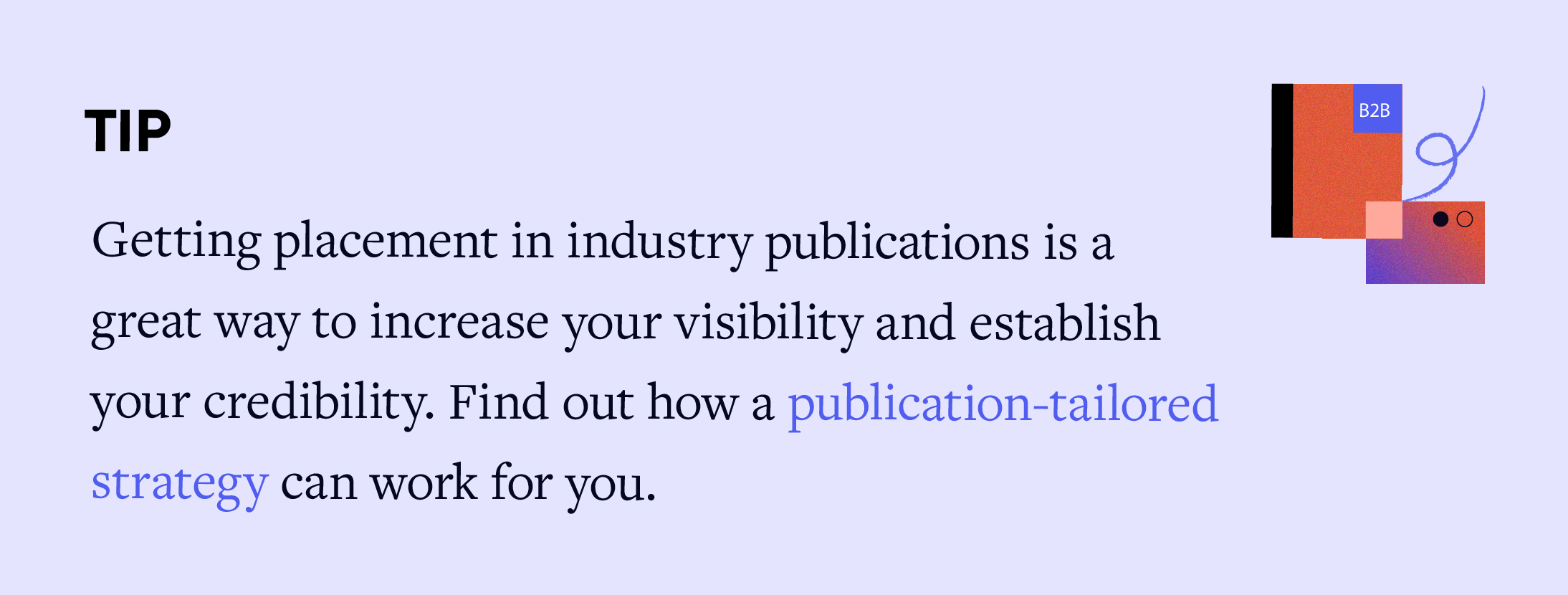
Step 8: Write your content plan.
The work you’ve done up to this point gives you the clarity you need to create content that will really resonate with your audience.
Remember: Content isn’t a one-and-done deal. In B2B, the time investment is greater than in B2C, which means you’re going to need to spend more time proving your value, demonstrating your expertise, and showing your audience what sets you apart. A steady stream of quality content is the best way to do that. But that doesn’t mean you should go with every idea you brainstorm. You need to be intentional and thoughtful about the ideas you choose and execute.
Only 68% of B2B marketers prioritize their audience’s informational needs over their organization’s sales/promotional message.
—Content Marketing Institute’s 2022 B2B Content Marketing Report
How to Do It
Creating the right content takes planning, skill, and the right resources. As you craft your content plan, here’s what to do to make things easier at every stage.
- Document your major events. Start by identifying the major holidays, company milestones, launches, and other significant events that you will need to account for (and brainstorm around) throughout the year. You won’t ideate a year’s worth of content at this point, but it’s important to know what significant things you need to think about as you plan your content each quarter. Use the Content Pipeline Template in the toolkit to get these all on paper.
- Brainstorm campaign ideas. There are endless campaigns you can run to promote your brand, but again, it’s crucial to know your goals and tailor content to meet your audience’s needs. Use our Marketing Campaign Template, follow these tips to ensure you’re delivering value in your content, and see our guide to run a successful B2B marketing campaign.
- Use empathy. Tap into your audience’s pain points, needs, and wants to create content that is relevant and interesting. Find out more about how to use empathy in your marketing, and get inspired by how these brands use empathy to connect with audiences.
- Vet your ideas. Use your personas to vet your ideas and ensure the content you create really will provide value to your audience. Start by asking these 5 questions about every idea.
- Join timely conversations. In the long game of B2B, trending topics can be a great way to make connections with people, as long as you have a unique perspective and can genuinely add value. If you’re not sure if you should chime in, find out how to newsjack without being a jackass.
- Don’t sell. Don’t start the conversation with a sales pitch. You want to establish a relationship first, then move your audience through your customer journey. For more tips to do this effortlessly, find out how to bridge marketing and sales in your buyer journey.
- Get inspiration from others. While a lot of B2B marketing is subpar, you can learn a lot from the standouts—even if they’re not in your own industry. To see how other brands are crushing B2B, take a look at these examples of A+ B2B marketing.
- Choose the right format. This is a huge step that many marketers overlook or think of as an afterthought. The format matters just as much as the message you’re delivering. For example, a snazzy data visualization may be a great way to capture people’s attention on Instagram, whereas a guest column in an industry publication is a great way to build brand awareness among industry decision-makers. If you’re not sure what form your idea should take, here’s a breakdown of different types of B2B content and how they help achieve your content goals.
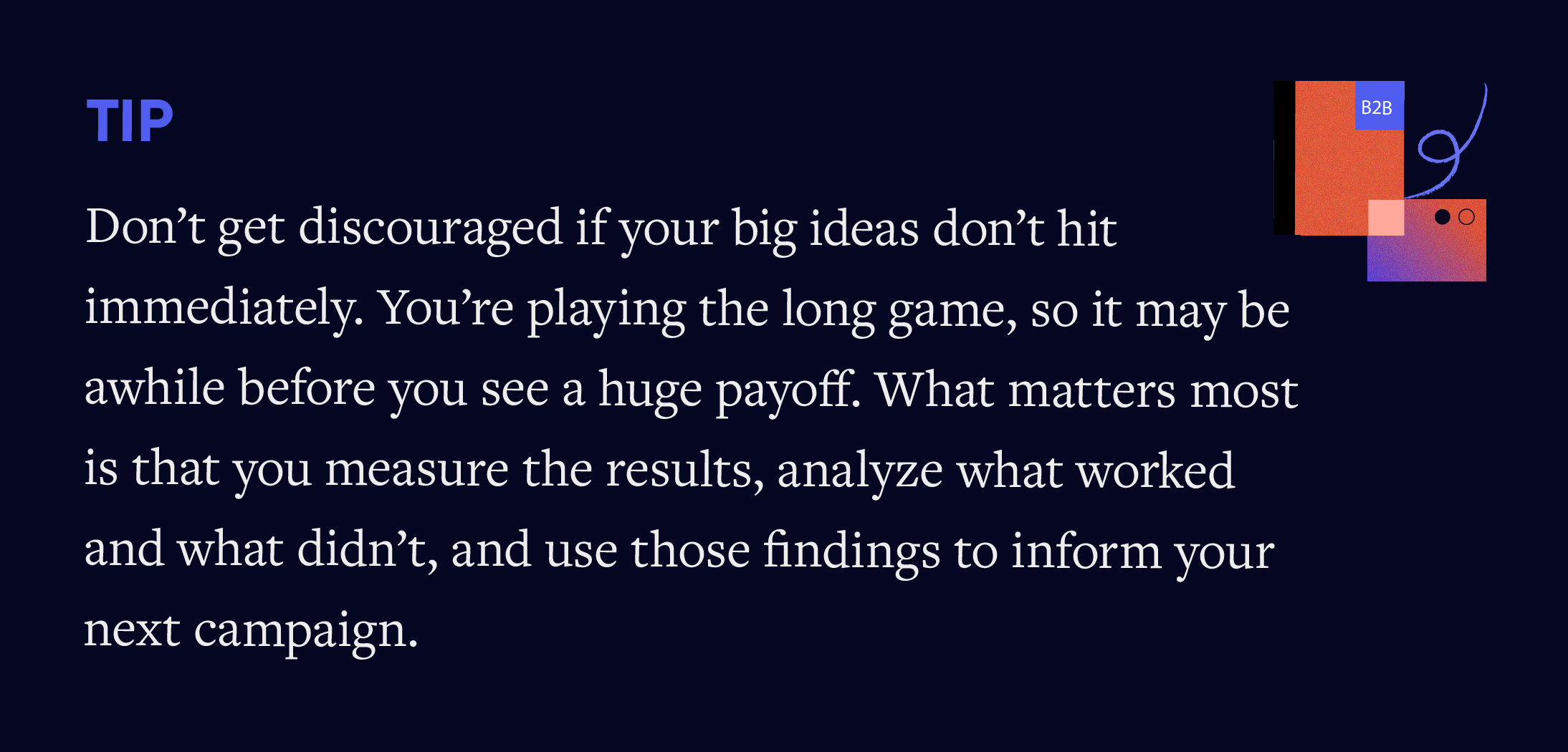
Step 9: Assign roles.
To do content marketing consistently and successfully, your team needs to be incredibly organized. One hiccup can cause major disruption down the line. (Trust us, if your copy is a week overdue, then your design delivery might be three weeks overdue.)
Ensuring everyone understands their responsibilities, timelines, and who owns what helps improve communication and accountability across the board.
How to Do It
Use the Workflow and Governance Template to document everyone’s duties and keep everyone on the same page.
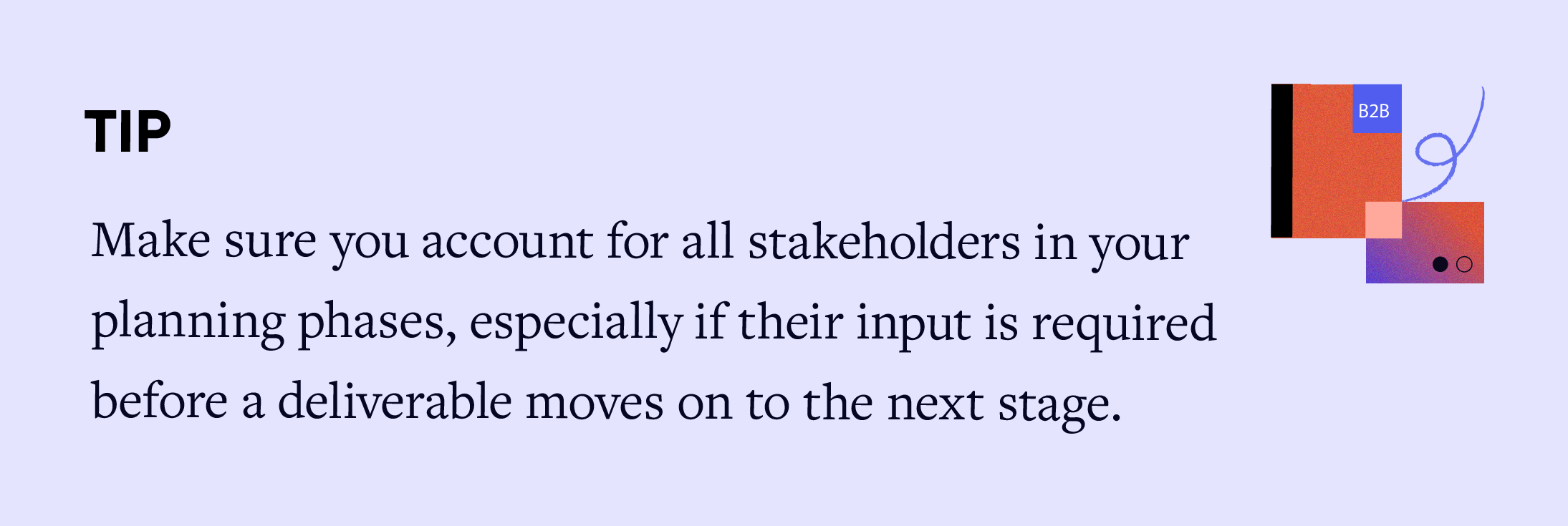
Step 10: Build your editorial calendar.
With your content plan on paper, it’s time to bring your strategy to life. With an editorial calendar, you can establish a consistent publishing cadence, understand what’s coming down the pipeline, allocate resources, and help everyone stay on schedule.
How to Do It
There are a variety of tools you can use to build and maintain your calendar. If you’re starting small, use our Editorial Calendar Template, and see our guide to creating a well-rounded editorial calendar.
Remember: From blog articles to Instagram posts, you want to curate the right mix of content to keep your audience engaged. Once you’re ready to start assigning each piece, use our Content Brief Template to keep your team aligned.
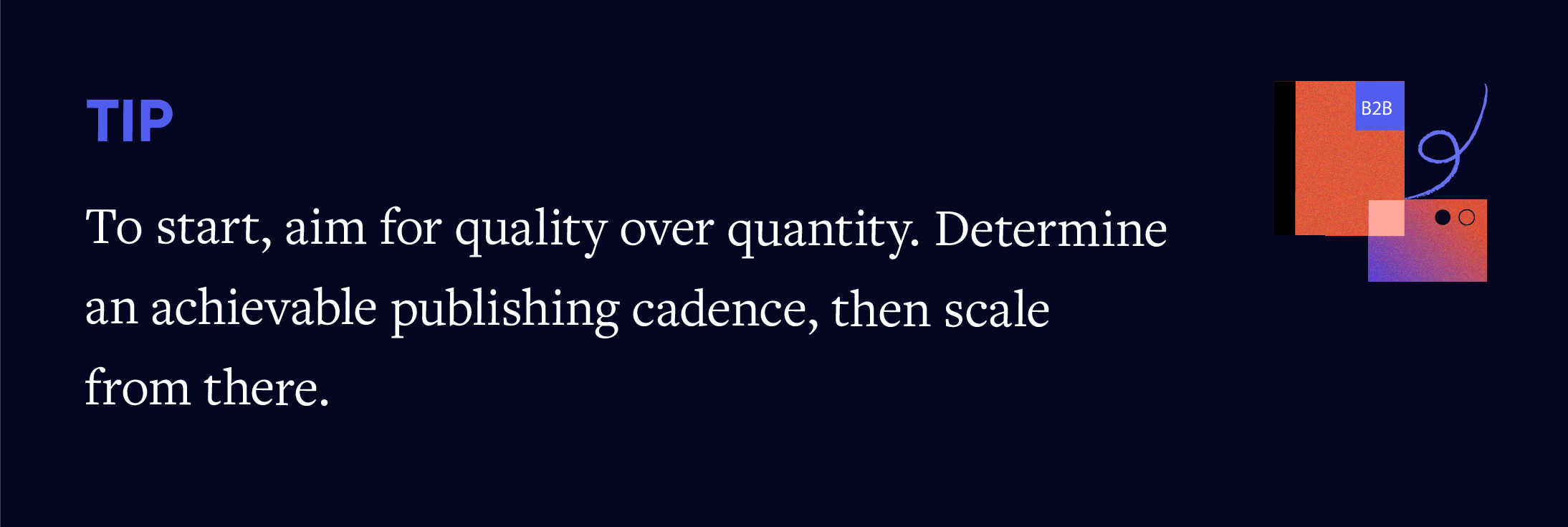
How to Improve Your B2B Marketing Going Forward
In content marketing, remember: Perfection is the enemy of progress. B2B marketing is an ever-evolving practice, so you can’t just set it and forget it. As you implement your strategy and start to gather insights, look for ways to strengthen your marketing across every touchpoint, both internally and externally.
- Create a seamless brand experience in your content. According to the Content Marketing Institute, only 30% of B2B marketers say they provide customers with a consistent experience across their engagement journey. Make sure your content is always on-brand.
- Follow best practices. From your content creation process to your copywriting, there is always room to improve your work. See our tips for writing marketing copy that converts, avoid these common mistakes in your visual content, and find out why content marketers should think like designers.
- Make the most of your content. According to the Content Marketing Institute, 60% of B2B marketers have been asked to do more with the same resources. Not only do you need to give the most value in your content but you need to get the most value from it. Find out how a divisible content strategy helps you make more content with less work.
- Experiment. It’s easy to get stuck in your ways, but the best marketers aren’t afraid to take calculated risks. The better your measurement infrastructure, the easier it is to test your hypotheses. So think of ways to mix up your approach—you might be pleasantly surprised by the results. (If you’re looking for some easy wins, though, try these tips to improve your ROI.)
- Measure and refine. Failing is not something to be ashamed of; not learning anything from your failure is. Find out how to measure the ROI of B2B to understand what is and isn’t working. And find out how to create a good marketing report to showcase your results in an easy-to-understand way.
That said, if you’re struggling to find success, consider bringing in the right support. Sometimes an extra pair of hands to execute your strategy (or guide it entirely) is all you need to get the results you want.
50% of B2B content marketers outsource their content marketing activities.
—Content Marketing Institute’s 2022 B2B Content Marketing report
If you’re looking for the right help, follow these 5 tips to find a B2B marketing agency with the right expertise, and find out how to build a productive working relationship when you find the right partner. Of course, you’re welcome to start your hunt with us.
Why C5?
- We help SaaS marketers scale their marketing on the road to IPO and beyond.
- We nurture productive long-term relationships with our partners. (In addition to the many brands we’ve helped over the last decade, we’ve worked with 40 brands for 5+ years.)
- We care about helping brands make better decisions for people, profit, and planet. Find out more about who we are, learn more about working with us on a content strategy, or reach out directly.
Whether we’re the right fit or not, we want you to get the best results you can get from your B2B strategy. We wish you good luck and lots of leads!





Now this is good content. You can tell that alot when into this post. Nice work.
Thanks a lot. We always try to create the resources we wish we’d had.
Thank you!